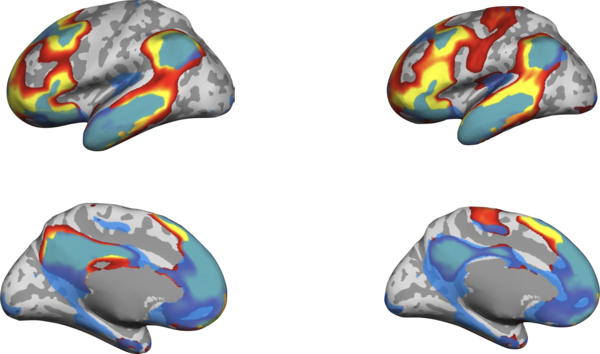Many brain regions that process language also control the insides of your body
A note for Lesson no. 5, "Your Brain Secretly Works With Other Brains," in Seven and a Half Lessons About the Brain by Lisa Feldman Barrett.
Some context from page 89 is:
Why do the words you encounter have such wide-ranging effects inside you? Because many brain regions that process language also control the insides of your body,...
The brain regions that scientists call the “language network” overlap to a large extent with a network called the “default mode network,” particularly on the left side of the brain.
Two spots in the left hemisphere of the cerebral cortex are known to be important for language, although they are not dedicated to language per se:
- Wernicke's Area (named for neurologist Carl Wernicke) is in the back (posterior) section of the temporal lobe, at the top (superior), or STG, and is important for language comprehension (among other things)
- Broca's Area (named for neurologist Paul Broca) is in the lower (interior) section of the frontal lobe, or the inferior frontal lobe (sometimes also called ventrolateral), and is important for language production (among other things)
It is possible to estimate the intrinsic brain network that is important for language by identifying which brain regions show changes in activity that fluctuate in sync with Wernicke's Area and Broca's Area. These regions are depicted from yellow to red in the image below. (Compare to Figure 16 in Dronkers 2011.[1]) This network of regions overlaps considerably with one of the two brain networks that is most responsible for regulation the internal systems of your body, called the default mode network, which is overlaid in blue.[2]

There is some debate about whether the assembly of neurons most responsible for processing the words you hear and speak is separable from these two other networks when using task-related brain activity, such as listening to sentences or remembering objects on a computer screen, rather than brain connectivity, as I have done here (e.g., see [3]). When reading such papers, it's important to realize that:
- Scientists often threshold their findings to make networks appear distinct (like Lego blocks), on the assumption that they must be separate, rather than to discover overlap where it might exist (as we have done here); and
- This study, like most of the others, does not localize body-budgeting (also called visceromotor control).
See also
- Other names for the interoceptive network (from the webnotes for How Emotions are Made: The Secret Life of the Brain)
- The neural processing of language is influenced by whether or not a person reads,[4] and it differs across languages.[5][6]
References
- ↑ Dronkers, Nina F. 2011. "The Neural Architecture of the Language Comprehension Network: Converging Evidence From Lesion and Connectivity Analyses." Frontiers in Systems Neuroscience 5: 1.
- ↑ Kleckner, Ian R., Jiahe Zhang, Alexandra Touroutoglou, Lorena Chanes, Chengie Xia, W. Kyle Simmons, Karen S. Quigley, Brad C. Dickerson, and Lisa Feldman Barrett. 2017. "Evidence For a Large-Scale Brain System Supporting Allostasis and Interoception in Humans." Nature Human Behavior 1 (5): 1–14.
- ↑ Mineroff, Zachary, Idan Asher Blank, Kyle Mahowald, and Evelina Fedorenko. (2018). "The Robust Dissociation Among Language, Multiple Demand, and Default Mode Networks: Evidence From Inter-Region Correlation Effect Size." Neuropsychologia 11: 501–511.
- ↑ Dehaene, Stanislas, Felipe Pegado, Lucia W. Braga, Paulo Ventura, Gilberto Nunes Filho, Antoinette Jobert, Ghislaine Dehaene-Lambertz, Régine Kolinsky, José Morais, and Laurent Cohen. 2010. "How Learning To Read Changes the Cortical Networks for Vision and Language." Science 330 (6009): 1359–1364.
- ↑ Majid, Asifa, and Stephen C. Levinson. 2010. "WEIRD Languages Have Misled Us, Too." Behavioral and Brain Sciences 33 (2-3): 103.
- ↑ Levinson, Stephen C. 2012. The Original Sin of Cognitive Science. Topics in Cognitive Science 4 (3): 396–403.